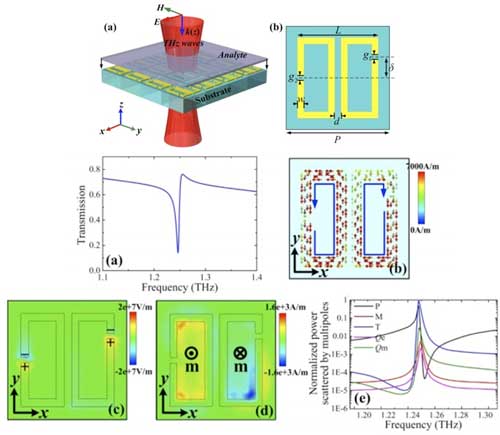| Jun 17, 2020 | |
Can metallic metasurfaces be used for terahertz nanofilm sensing?(Nanowerk News) For ultrasensitive sensors, the high Q resonance with extremely narrow bandwidth is important and necessary, which indicates the lower rate of energy losses and supports strong interaction between electromagnetic waves and analytes. |
|
| However, the metallic metasurfaces are unavoidable to suffer serious obstacles like material loss and joule heating, resulting a relatively low Q-factor which is a challenge for terahertz (THz) nanofilm sensing due to the reduced interaction strength. Are there any methods to make the metallic structure used for THz nanofilm sensing? | |
| Recent studies have shown that toroidal dipoles (TDs) or bound states in the continuum (BIC) based metasurfaces are highly sensitive to the change of surrounding medium and suitable for sensing applications. | |
| A research team led by Prof. Dr. FAN wenhui from Xi'an Institute of Optics and Precision Mechanics (XIOPM) of the Chinese Academy of Sciences (CAS) firstly proposed a TD-BIC inspired Fano resonance metasurface, exhibiting both TD and BIC feature in the same structure. | |
| The results were published in Optics Express ("Toroidal dipole bound states in the continuum metasurfaces for terahertz nanofilm sensing"). | |
| In their design, the structure consists of two Aluminum SRRs deposited on a cyclic olefin copolymer substrate. By broken symmetry of the unit cell, the TD resonance and the BIC mode are both excited. With suppressed radiation losses, the high Q-factor can be achieved by Fano resonance with sharp spectral profile. | |
 |
|
| Schematic of the proposed structure and calculated results. (Image: XIOPM) | |
| Simulation results show the Q-factor has a high Q value in terahertz metallic metasurfaces. Moreover, with coating 40 nm analytes overlayer, the sensitivity of the amplitude difference can achieve 0.32/RIU, which also can be easily detected comparing with the frequency shift method with sensitivity of 1.96 GHz/RIU. | |
| The proposed sensor combined with the amplitude difference referencing technique can be utilized to identify nanofilm analytes and pave a way for new generation THz label-free sensors. |
| Source: Chinese Academy of Sciences | |
|
Subscribe to a free copy of one of our daily Nanowerk Newsletter Email Digests with a compilation of all of the day's news. |
